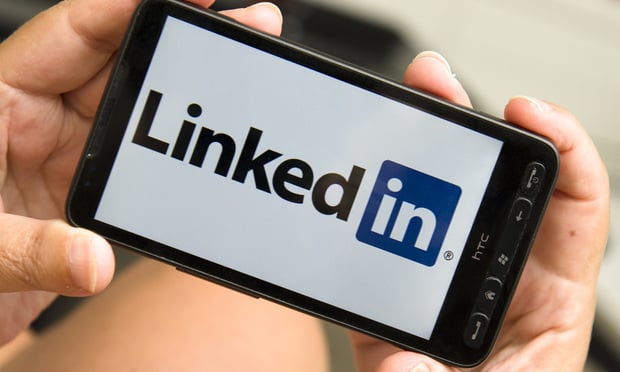Applying Business Process Improvement Concepts to One's LinkedIn Program
Properly administered, LinkedIn can help those in the corporate legal field expand their horizons to develop more strategies for extracting more bang for your legal buck, improving litigation and document review workflows and analyzing spend using business analytical tools and A.I.
July 08, 2019 at 01:13 PM
8 minute read
 Within the legal industry, the business process improvement goals of corporate law departments are generally understood. Concepts such as collaboration, innovation, cost optimization and mechanization are amongst the pots of gold sitting at the end of the proverbial rainbow. Specific objectives such as automating common legal tasks, defining and maximizing the value derived by legal spend, using advanced technology to efficiently process and glean key elements from documents, and implementing both outside counsel and vendor management programs are just a few of the process improvement goals typically resident within an organization's internal legal function.
Within the legal industry, the business process improvement goals of corporate law departments are generally understood. Concepts such as collaboration, innovation, cost optimization and mechanization are amongst the pots of gold sitting at the end of the proverbial rainbow. Specific objectives such as automating common legal tasks, defining and maximizing the value derived by legal spend, using advanced technology to efficiently process and glean key elements from documents, and implementing both outside counsel and vendor management programs are just a few of the process improvement goals typically resident within an organization's internal legal function.
But how do you get started? What works well and what does not? And how should one prioritize improvement projects? That's not always so easy to wrap your arms around.
For generations, one approach for new ideas has been connecting with thought leaders to discuss and exchange ideas. Long ago, industry leaders exchanged ideas in the grand meeting rooms or laboratories of venues like Hyde Park, the Edison House or public town halls. More recently, business leaders tend to gather at industry association conferences or rely on advice from experts at professional consulting firms. Human interaction was, of course, a familiar refrain in these types of exchanges.
Our world is increasingly changing. To state the incredibly obvious, it's a more digital place. As sad as is in some ways, electronic interaction is either replacing or supplementing personal interaction, depending on your point of view. Thus, it should be no surprise that this phenomenon also applies to the areas of benchmarking and improvement within the legal industry.
Accordingly, business networking tools like LinkedIn are now significant influencers in the workflow and process improvement arena. Of course, we all have heard of LinkedIn and have a general idea of what it is and what it can do. But how do we apply the same level of business process methodologies to our use of LinkedIn? Here are some tips.
Develop a Plan
We are all used to developing plans. To technologists like myself, coordinated application builds by developing business requirements, writing functional specifications and managing implementation teams. Litigators walk through phases of a case such as case assessment, pre-trial pleadings and motions, discovery, settlement negotiations, trial, etc.. And, more narrowly within the burgeoning area of discovery, there is a model for that function (The Electronic Discovery Reference Model or EDRM) which defines a generally accepted optimized workflow (Identification, Preservation, Collection, Processing).
It stands to reason members of a corporate counsel office need a “LinkedIn” plan as well. Perhaps the first thing to acknowledge is that there is indeed some value of LinkedIn as a business tool. Attorneys, and in fact all processionals, need to commit themselves to the belief that LinkedIn is far more than just “Facebook For Business”. On the contrary, LinkedIn should be considered a valued business tool.
So, what are some ways LinkedIn can be applied to further one's personal objectives? Like managing a case or discovery project, the first step is developing a plan of attack. One's general goals might include any or all of the following—do a better job, develop better skills, help others around you be better, or even to get a better job. Of course, not unlike creating customized software or managing a legal matter, a LinkedIn strategy plan should be tailored to specific needs. No one can define a plan for another. But do be sure to develop a customized plan for yourself.
Lay the Foundation
Not unlike rebuilding a sports franchise, a properly executed LinkedIn strategy takes time, effort, and vision to implement. Logging in occasionally and clicking the “Like” icon here or there won't cut the mustard. So what should a member of an organization's law department be doing?
One of the first goals is to build and expand your network. There are so many options in this area. Your current colleagues within your corporate law department. Those you worked with in the past. College roommates. Experts in your specific field of law, and others, from academia or the consulting industry. If you happen to be a litigation attorney working in Big Pharma, why not network with some legal experts within your firm in areas like trademark, patent or contractual law.
Don't forget your internal clients, employees in departments like finance, product development and marketing. And your business partners like outside counsel. And, of course, recruiters are another obvious category as well.
Try to be sure you identify those folks best aligned with your overall LinkedIn plan. For example, you have an interest in outside counsel management programs, look for contacts with vendor management experience within the legal vertical. Those folks could serve as valuable thought leaders to you. Building a strong network is vital—clearly one of the major foundational steps within a LinkedIn program.
One quick tip. Executing this plan to expand your contacts should be done with some care. Try to first connect with those you personally know. Ask your contacts for introductions to others. Send personalized invites indicating why you are interested in connecting whenever possible. Try to make that first interaction a personal one which you can build upon.
The Sill Plate
If this is a new term to you, a sill plate is the first portion of a house frame that sits right on top of the concrete. If your contacts are your LinkedIn foundation, your external content and expertise is your sill plate. Speaking at conferences, writing articles or even sharing interesting thoughts on LinkedIn all make you the type of knowledgeable, introspective professional that others will want to connect with.
Remember, whether you are in the halls of a courthouse, attending an ABA conference and commiserating online, the more insightful you are perceived to be, the more beneficial your interactions will be. LinkedIn really is no different, just an extension of one's personal contacts.
A note of caution however. Don't produce content for content's sake. Just because you can write articles directly on LinkedIn, that does not necessarily mean it is a great idea. Expressing well thought out concepts focused on topics of interest supporting the goals of your LinkedIn program is a good idea. That's where you want to be content wise.
Finishing Touches
Once you have a supporting mechanism in place, that's where the fun begins. Budget some time for the process. Strive for some thought-provoking two-way engagements. Respond to the content of others and show interest in areas you'd like to learn about. And when you are working in the LinkedIn platform, try to make a few introspective comments rather than just clicking on the “Like” button something on the order of seventeen times per minute. Lastly, be sure to reciprocate to those who read and support your content by showing an interest in their material. That's the way to develop those two-way, mutually beneficial relationships.
Most importantly, don't be shy about reaching out to others to further your goals. That's the whole purpose of LinkedIn, to gain and benefit from the thoughts and experiences of your contacts.
One last tip, and my apologies for repeating this. Try to get into the habit of working in the LinkedIn platform every day. Not hours of work. Perhaps something in the range of 5-10 minutes a day seems about right to me. Like any social media platform, total immersion into LinkedIn is not what you want to do.
Keep this last point in mind. LinkedIn is not Formula 1. Slow and steady—think perhaps a modest goal of adding a 3-5 contacts per week and posting some content or comments a couple times of month—is a sustainable pace which will help you get the most out of your LinkedIn program.
Conclusion
Consider LinkedIn a valuable business tool. Make it part of your overall plan to benefit from the excellent ideas and experiences of others working within the corporate counsel function. Properly administered, LinkedIn can help those in the corporate legal field expand their horizons to develop more strategies for extracting more bang for your legal buck, improving litigation and document review workflows and analyzing spend using business analytical tools and A.I.
There are many great ideas out there, the challenge facing corporate counsel is identifying the best approaches for implementing best-in-breed approaches. LinkedIn can play an important role in that process.
Kenneth Jones is Chief Technologist of Tanenbaum Keale, a boutique litigation law firm, and Chief Operating Officer of the Xerdict Group, a SaaS legal collaboration software company. Xerdict is a wholly owned subsidiary of Tanenbaum Keale.
This content has been archived. It is available through our partners, LexisNexis® and Bloomberg Law.
To view this content, please continue to their sites.
Not a Lexis Subscriber?
Subscribe Now
Not a Bloomberg Law Subscriber?
Subscribe Now
NOT FOR REPRINT
© 2025 ALM Global, LLC, All Rights Reserved. Request academic re-use from www.copyright.com. All other uses, submit a request to asset-and-logo-licensing@alm.com. For more information visit Asset & Logo Licensing.
You Might Like
View All
AI Disclosures Under the Spotlight: SEC Expectations for Year-End Filings
5 minute read
What to Know About the New 'Overlapping Directorship' Antitrust Development
4 minute read
Best Practices for Adopting and Adapting to AI: Mitigating Risk in Light of Increasing Regulatory and Shareholder Scrutiny
7 minute read
GCs Must Act Now to Prepare for the Trump Administration’s First Months
8 minute readTrending Stories
Who Got The Work
J. Brugh Lower of Gibbons has entered an appearance for industrial equipment supplier Devco Corporation in a pending trademark infringement lawsuit. The suit, accusing the defendant of selling knock-off Graco products, was filed Dec. 18 in New Jersey District Court by Rivkin Radler on behalf of Graco Inc. and Graco Minnesota. The case, assigned to U.S. District Judge Zahid N. Quraishi, is 3:24-cv-11294, Graco Inc. et al v. Devco Corporation.
Who Got The Work
Rebecca Maller-Stein and Kent A. Yalowitz of Arnold & Porter Kaye Scholer have entered their appearances for Hanaco Venture Capital and its executives, Lior Prosor and David Frankel, in a pending securities lawsuit. The action, filed on Dec. 24 in New York Southern District Court by Zell, Aron & Co. on behalf of Goldeneye Advisors, accuses the defendants of negligently and fraudulently managing the plaintiff's $1 million investment. The case, assigned to U.S. District Judge Vernon S. Broderick, is 1:24-cv-09918, Goldeneye Advisors, LLC v. Hanaco Venture Capital, Ltd. et al.
Who Got The Work
Attorneys from A&O Shearman has stepped in as defense counsel for Toronto-Dominion Bank and other defendants in a pending securities class action. The suit, filed Dec. 11 in New York Southern District Court by Bleichmar Fonti & Auld, accuses the defendants of concealing the bank's 'pervasive' deficiencies in regards to its compliance with the Bank Secrecy Act and the quality of its anti-money laundering controls. The case, assigned to U.S. District Judge Arun Subramanian, is 1:24-cv-09445, Gonzalez v. The Toronto-Dominion Bank et al.
Who Got The Work
Crown Castle International, a Pennsylvania company providing shared communications infrastructure, has turned to Luke D. Wolf of Gordon Rees Scully Mansukhani to fend off a pending breach-of-contract lawsuit. The court action, filed Nov. 25 in Michigan Eastern District Court by Hooper Hathaway PC on behalf of The Town Residences LLC, accuses Crown Castle of failing to transfer approximately $30,000 in utility payments from T-Mobile in breach of a roof-top lease and assignment agreement. The case, assigned to U.S. District Judge Susan K. Declercq, is 2:24-cv-13131, The Town Residences LLC v. T-Mobile US, Inc. et al.
Who Got The Work
Wilfred P. Coronato and Daniel M. Schwartz of McCarter & English have stepped in as defense counsel to Electrolux Home Products Inc. in a pending product liability lawsuit. The court action, filed Nov. 26 in New York Eastern District Court by Poulos Lopiccolo PC and Nagel Rice LLP on behalf of David Stern, alleges that the defendant's refrigerators’ drawers and shelving repeatedly break and fall apart within months after purchase. The case, assigned to U.S. District Judge Joan M. Azrack, is 2:24-cv-08204, Stern v. Electrolux Home Products, Inc.
Featured Firms
Law Offices of Gary Martin Hays & Associates, P.C.
(470) 294-1674
Law Offices of Mark E. Salomone
(857) 444-6468
Smith & Hassler
(713) 739-1250






